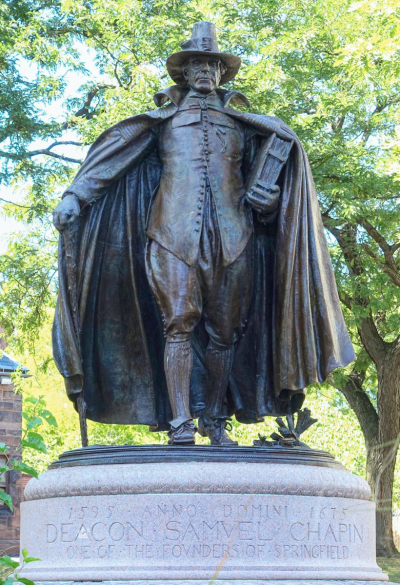The Massachusetts Bay Colony (16301691), more formally The Colony of Massachusetts Bay, was an English settlement on the east coast of America around the Massachusetts Bay, the northernmost of the several colonies later reorganized as the Province of Massachusetts Bay. The lands of the settlement were in southern New England, with initial settlements on two natural harbors and surrounding land about 15.4 miles (24.8 km) apartthe areas around Salem and Boston, north of the previously established Plymouth Colony. The territory nominally administered by the Massachusetts Bay Colony covered much of central New England, including portions of Massachusetts, Maine, New Hampshire, and Connecticut.
The Massachusetts Bay Colony was founded by the owners of the Massachusetts Bay Company, including investors in the failed Dorchester Company, which had established a short-lived settlement on Cape Ann in 1623. The colony began in 1628 and was the company's second attempt at colonization. It was successful, with about 20,000 people migrating to New England in the 1630s. The population was strongly Puritan and was governed largely by a small group of leaders strongly influenced by Puritan teachings. It was the first slave-holding colony in New England, and its governors were elected by an electorate limited to freemen who had been formally admitted to the local church. As a consequence, the colonial leadership showed little tolerance for other religious views, including Anglican, Quaker, and Baptist theologies.
The colonists had good relationships with the local Indians, however they did join their neighbor colonies in the Pequot War (163638) and King Philip's War (167578). After which most of the Indians in southern New England made peace treaties with the colonists or were sold into slavery after King Philips's War (apart from the Pequot tribe, whose survivors were largely absorbed into the Narragansett and Mohegan tribes following the Pequot War).The Massachusetts Bay Colony was economically successful, trading with England, Mexico and the West Indies. In addition to barter, transactions were done in English pounds, Spanish "pieces of eight", and wampum in the 1640s. A shortage of currency prompted the colony to call on the respected John Hull to establish a mint and serve as mintmaster and treasurer in 1652. The Hull Mint produced oak tree, willow tree, and pine tree shillings.
Political differences with England after the English Restoration led to the revocation of the colonial charter in 1684. King James II established the Dominion of New England in 1686 to bring all of the New England colonies under firmer crown control. The Dominion collapsed after the Glorious Revolution of 1688 deposed James, and the Massachusetts Bay Colony reverted to rule under its revoked charter until 1691, when a new charter was issued for the Province of Massachusetts Bay. This new province combined the Massachusetts Bay territories with those of the Plymouth Colony and proprietary holdings on Nantucket and Martha's Vineyard. Sir William Phips arrived in 1692 bearing the charter and formally took charge of the new province.
The Puritans were English Protestants in the 16th and 17th centuries who sought to purify the Church of England of Roman Catholic practices, maintaining that the Church of England had not been fully reformed and should become more Protestant. Puritanism played a significant role in English history, especially during the Protectorate.
Puritans were dissatisfied with the limited extent of the English Reformation and with the Church of England's toleration of certain practices associated with the Roman Catholic Church. They formed and identified with various religious groups advocating greater purity of worship and doctrine, as well as personal and corporate piety. Puritans adopted a Reformed theology and, in that sense, were Calvinists (as were many of their earlier opponents). In church polity, some advocated separation from all other established Christian denominations in favour of autonomous gathered churches. These Separatist and independent strands of Puritanism became prominent in the 1640s, when the supporters of a presbyterian polity in the Westminster Assembly were unable to forge a new English national church.
By the late 1630s, Puritans were in alliance with the growing commercial world, with the parliamentary opposition to the royal prerogative, and with the Scottish Presbyterians with whom they had much in common. Consequently, they became a major political force in England and came to power as a result of the First English Civil War (1642–1646). Almost all Puritan clergy left the Church of England after the restoration of the monarchy in 1660 and the 1662 Uniformity Act. Many continued to practice their faith in nonconformist denominations, especially in Congregationalist and Presbyterian churches. The nature of the movement in England changed radically, although it retained its character for a much longer period in New England.
Puritanism was never a formally defined religious division within Protestantism, and the term Puritan itself was rarely used after the turn of the 18th century. Some Puritan ideals, including the formal rejection of Roman Catholicism, were incorporated into the doctrines of the Church of England; others were absorbed into the many Protestant denominations that emerged in the late 17th and early 18th centuries in North America and Britain. The Congregational churches, widely considered to be a part of the Reformed tradition, are descended from the Puritans. Moreover, Puritan beliefs are enshrined in the Savoy Declaration, the confession of faith held by the Congregationalist churches.

1628Sep, 6
Puritans settle Salem which became part of Massachusetts Bay Colony.
Choose Another Date
Events on 1628
- 23Aug
John Felton (assassin)
George Villiers, the first Duke of Buckingham, is assassinated by John Felton. - 6Sep
Massachusetts Bay Colony
Puritans settle Salem which became part of Massachusetts Bay Colony. - 28Oct
Siege of La Rochelle
French Wars of Religion: The Siege of La Rochelle, which had lasted for 14 months, ends with the surrender of the Huguenots.

 English
English  español
español  français
français  português
português  русский
русский  العربية
العربية  简体中文
简体中文 